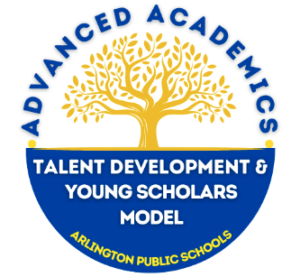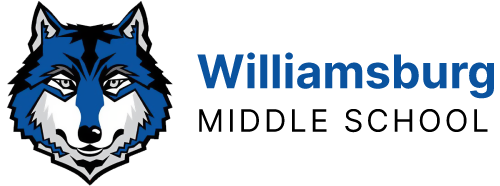
Arlington Public Schools is dedicated to maximizing the strengths and potential of all students so they may become self-confident, well-rounded, responsible, and productive citizens. Gifted services are implemented through school-based and countywide activities, which comply with School Board and State objectives. The Office of Advanced Academics and Talent Development ensures that school-based services are delivered in the following ways:
- The Collaborative Resource Model
- According to a collaborative resource model in which the classroom teacher works with the Advanced Academics Coach (AAC) to develop and present appropriately differentiated learning experiences for advanced learners within the general education classroom
- Cluster Grouping Within the Classroom, (6th Grade in Science, Social Studies, Reading, and English, 7th & 8th Grade in Intensified courses)
- In the general education classroom setting with identified students cluster-grouped and through a variety of flexible groupings based on ongoing data
- Differentiation of Curricula
- With teachers who are specifically trained in instructional needs of and curriculum written for advanced and gifted learners
- Through curricula which are differentiated or extended from concepts in the general education curriculum, and when appropriate, through opportunities for enrichment and extension
- Acceleration
- Students that demonstrate aptitude (skills or higher level understanding) in mathematics are able to take higher level courses.
The APS Advanced Academics and Talent Development Office is guided by the 2022-2027 APS Gifted Services Local Plan.
Differentiation
The Advanced Academic Coach (AAC) serves as an ongoing support for daily differentiation by sharing resources and strategies to support differentiation for gifted/advanced learners. According to Tomlinson, (2018), “Differentiation is a way of thinking about teaching and learning that places students in the foreground of teacher thinking and planning.” Differentiation within the classroom accounts for student readiness, provides opportunities for choice in learning, and increases engagement. For a better understanding of definitions and strategies that are related to differentiation, select this link. In addition to differentiation within the classroom setting, students are offered choice in elective courses starting in the 7th grade. The opportunity to choose what they are learning, helps increase student engagement. Research by Herbert (1993) and Renninger (1990) supports this by stating “When students are interested in what they study, there are positive influences on learning in both the short and long term.” Tomlinson (2018) also states “Differentiation in the classroom setting for all learners leads to…
- extended equity of access and excellent learning opportunities for more students,
- a community of learners,
- a high quality curriculum,
- stronger student ownership of learning,
- and address students’ readiness needs, interests, and approaches to learning.”
Looking for ways to provide enrichment as a parent? Select this link to be taken to our Parent Resources for Enrichment and Challenge Page
The Collaborative Resource Model
This model is built upon the work of Dr. Mary Landrum of JMU and Dr. Carol A. Tomlinson of UVA. The Collaborative Instructional Resource Teacher for the Gifted model has been incorporated in the schools to provide support in the instruction of gifted and highly able children and the differentiation of curriculum to challenge the potential of all students.
The AAC engages the classroom teacher in a collaborative instructional model that includes co-planning, collaborative teaching, and one-on-one professional development focused of specific gifted instructional methodology.
AAC Roles and Responsibilities
- Collaborate and co-plan with teachers to extend and deepen student learning through higher level discussion, rich content, and high expectations
- Provide supplemental resources
- Model lessons, co-instruct, or facilitate lessons using best practices and instructional strategies (i.e. APS’ K-12 Critical and Creative Thinking Strategies)
- Facilitate extension projects
- Promote differentiation practices throughout the school
- Manage gifted and talented screening process and evaluation
- Facilitate professional development for teachers
Classroom Teacher’s Role and Responsibilities
- Collaborate with the AAC to provide differentiated curriculum, extension opportunities, and supplemental curriculum resources
- Plan units and lessons to meet the learning needs of students eligible for gifted services
- Coordinate instructional needs of all learners in the classroom
- Keep open communication with the AAC on students that may need to be screened for gifted services
The Gifted Cluster Model: Students enrolled in 6th, 7th, & 8th grade intensified English, Science, and Social Studies will be placed in gifted clusters -this does NOT include World Geography- which is already a high school course.
The Gifted Cluster model provides services to identified students by placing identified students with intellectual peers. The classroom teacher, with the support of the AAC, is the primary provider for Gifted Services and provides differentiation for gifted students within the curriculum. There are several advantages of this model. They include…
- Students have intellectual peers necessary for academic and social development all day.
- Gifted students have the opportunity to be challenged on a continuous basis, not just once or twice a week.
- Non-identified students, who also need challenge, will have the opportunity to try out advanced curriculum or strategies.
Acceleration
According to Assouline, et al. (2018) “Acceleration is an empirically effective intervention for high-ability students with positive academic, social, and psychological short-term and long-term outcomes.” This curriculum model presents students with content at a faster pace and addresses the academic needs of high-ability students with appropriate and advanced educational curriculum (p. 173). At WMS, opportunities for acceleration can be found in our mathematics curriculum allowing for students with a high aptitude in math to move through content as needed and be challenged appropriately. Decisions for math placement occur at the end of the school year for the following school year. The math department sends information to parents regarding this process in the spring.
References
Arlington Public Schools. https://www.apsva.us/gifted-services/
Arlington Public Schools. (2017). Local Plan for the Education of the Gifted. https://www.apsva.us/gifted-services/2017-2022-gifted-services-local-plan/
Assouline, S., Lupkowski-Shoplik, A., and Colangelo. (2018). Evidence Overcomes Excuses: Academic Acceleration Is An Effective Intervention for High Ability Students. In C.M. Callahan & H.L. Hertberg-Davis (Eds.), Fundamentals of Gifted Education: Considering Multiple Perspectives. (2nd ed. pp. 279-292). Routledge.
Herbert, T. (1993). Reflections at graduations: The long-term impact of elementary school experiences in creative productivity. Roeper Review, 16, 22-28.
Partington, K. (2019). Dorothy Hamm Middle School. https://dorothyhamm.apsva.us/gifted-services/
Renniger, K. (1990). Children’s play interests, representations, and activity, In R. Rivush & J. Hudson (Eds.), Knowing and remembering in young children ((Emory Cognition Series, Vol. 3, pp.127-165). New York: Cambridge University Press.
Tomlinson, C. (2018). Differentiated Instruction. In C. M. Callahan & H. L. Hertberg-Davis (Eds.), Fundamentals of Gifted Education: Considering Multiple Perspectives. (2nd ed. pp. 279-292). Routledge.
 Contact
Contact  Calendars
Calendars Careers
Careers Engage
Engage  District
District
